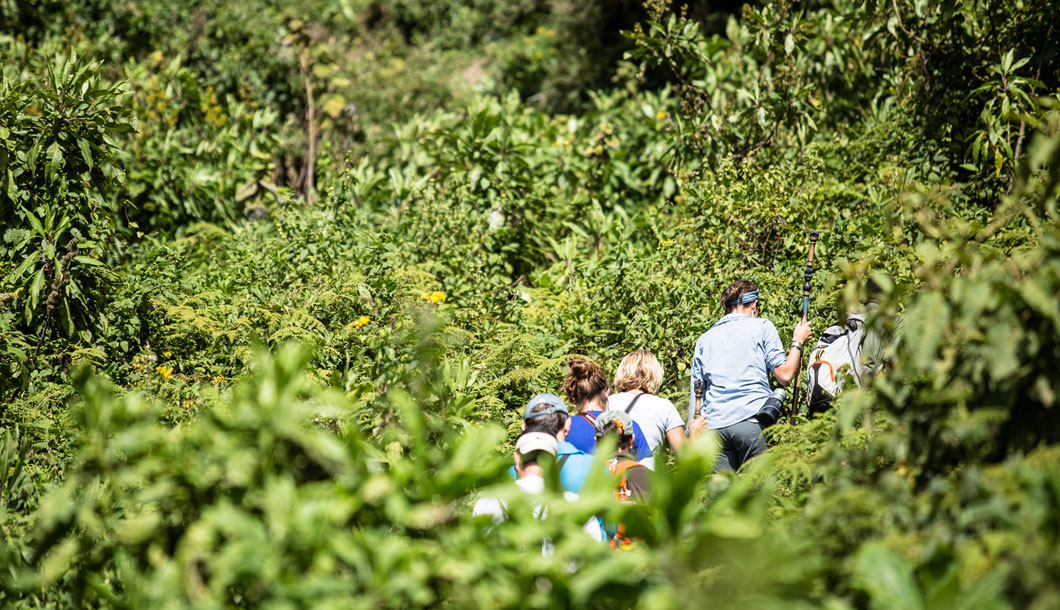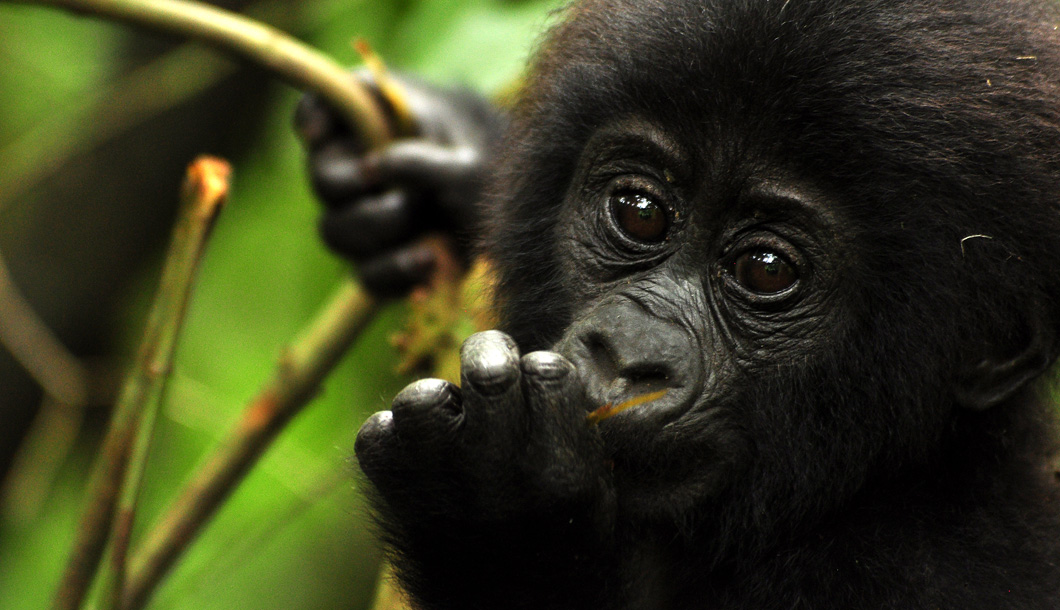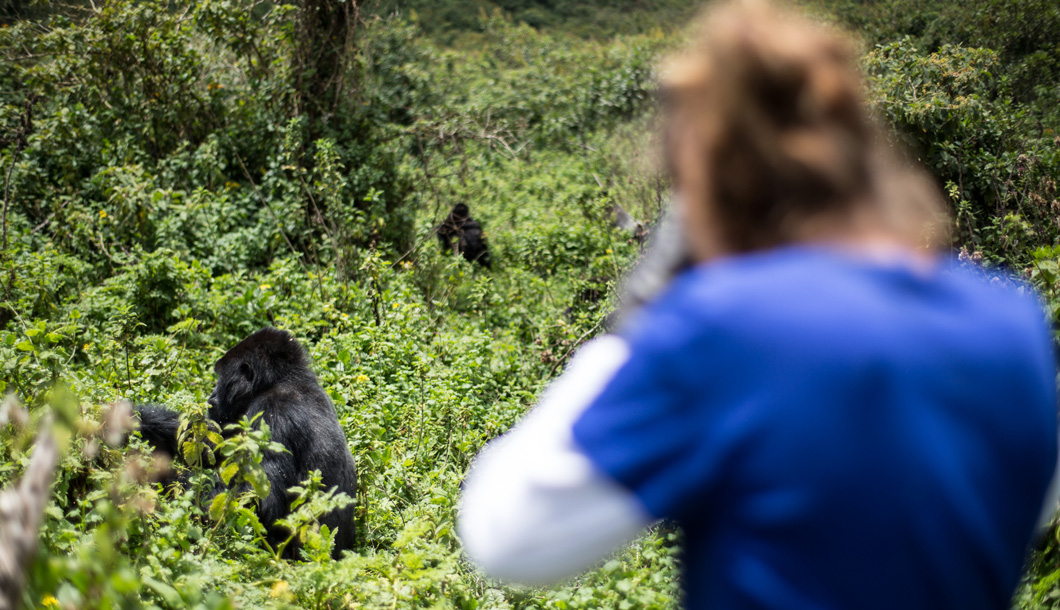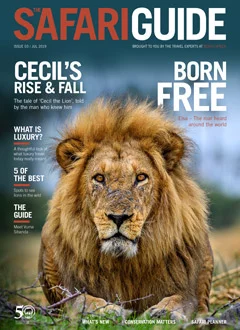We hope that you will find this Information on Gorilla Trekking useful for reference when preparing for your holiday.
All the information contained in this document was correct at the time of writing and is to be used as a guide only. Health, visa and other specific details should be double checked by your travel agent at the time of booking.
Fitness
Whether you are Gorilla tracking in Uganda or gorilla tracking in Rwanda it can be strenuous. You must be physically fit to enjoy the trek. You should be able to climb steep inclines (often steeper than a flight of stairs) and negotiate dense vegetation that gives the park its name.
Guidelines for visitors when tracking the gorillas
Rules and guidelines have been carefully developed to try to protect the mountain gorillas’ health and safety. Gorillas are extremely susceptible to human diseases and infections, and become stressed if too many visitors arrive or approach too closely. Remember that they are wild individuals, and very protective of their young. To remain healthy and survive these apes need to be undisturbed by visitors, and allowed to eat, rest and socialize with their own species.
Whilst you have a very good chance of seeing the gorillas, success is not guaranteed. They are wild creatures with no fixed routine and finding them requires the skill and experience of your trackers and guides as well as luck.
Health
If a tourist is ill, the park staff will have the right to refuse a visit to gorillas. Gorillas are susceptible to many human diseases and it has long been feared by researchers that one ill tourist might infect a gorilla, resulting in the possible death of the whole troop should they have no immunity to that disease. For this reason, you should not go gorilla tracking with a potentially airborne infection such as flu or a cold and are asked to turn away from the gorillas should you need to sneeze in their presence.
Safety
To the best of our knowledge, no tourist has ever been seriously hurt by habituated gorillas. An adult gorilla is much stronger than a person and will act in accordance with
its own social codes. Therefore it is vital that you listen to your guide at all times regarding correct protocol in the presence of gorillas.
Rules & Regulations
• A maximum number of 6-8 (depending on which family you are tracking) visitors may visit a group of habituated gorillas in a day. This minimises behavioural disturbance to the gorillas and the risk of their exposure to human-borne diseases.
• Always wash your hands before you head out to the gorillas.
• Do not leave rubbish in the park. Whatever you bring into the forest should be
carried back with you.
• You will be taken to where the guides left the gorillas the day before. From there you
will follow the gorillas trail to find them. Look out for the gorillas nesting sites along
the way.
• When you approach the gorillas, the guides will inform you when to get your
cameras ready. Flash photography is NOT permitted! When taking pictures, move
slowly and carefully.
• Please always keep your voices low. You will also then be able to observe the
great bird life and other wildlife in the forest. However, it is okay to ask the
guide questions.
• Body language is important, and visitors should not raise hands or arms, or point, nor
stare at them.
• The maximum time you can spend with the gorillas is one hour. However, if the
gorillas become agitated or nervous, the guide will end the visit early.
• You must stay in a tight group when you are near the gorillas.
• Visitors should not clear vegetation close to gorillas so that they get a better view.
• It is forbidden to eat or smoke while you are near the gorillas. Eating or drinking
inevitably will increase the risk of food/drink morsels/droplets falling, which could
increase the risk of transmission of diseases.
• It is to approach within less then 10 metres of the gorillas, a rule that is difficult
to enforce with curious youngsters (and some adults) who often approach human visitors. If great apes approach you from within 2 -3 metres (as curious juveniles sometimes do), then visitors should slowly retreat. If this is not possible, then the visitors will be asked to remain where they are.
• The guide’s instructions should be followed at all times.
• Keep your backpack and other items in places where young gorillas can’t approach
and investigate them.
• Sometimes the gorillas may charge. If this happens follow the guide’s example -
crouch down slowly, DO NOT look at the gorillas directly in the eyes, wait for the
animals to pass. DO NOT attempt to run away. Running away will increase the risk.
• DO NOT touch the gorillas. They are wild animals.
• After the visit, keep your voices down until you are 200 metres from the gorillas.
• All visitors who wish to trek the endangered mountain gorillas must be at least fifteen years of age.
Tipping your guide and porters
Tipping is a delicate and sensitive issue and many people ask us for tipping guidelines. Tipping is usually considered customary in Africa although not as widespread as the United States or Europe but it is always at your discretion. If you feel that someone has gone the extra mile to make your stay more enjoyable, a tip would be considered a nice way of saying thank you.
To help you budget for your trip, the following is given as a guideline only (shown in AUD, but please tip equivalent in local currency or US Dollars):
Gorilla Guides - Main guide (per person) AU$15
Gorilla Porter (per person) AU$10
Trekking time
Time taken to track gorillas varies enormously, from as little as half an hour to as much as 9 hours before one returns to camp. The trek normally starts at 8.30 am and can last the whole day.
What to wear and take
Whichever family group you visit, you may have to walk a long distance in steep, muddy conditions, possibly with rain overhead, before you encounter any gorillas. Put on your sturdiest shoes. Ideally, wear thick trousers and long sleeved top to protect against vicious stinging nettles.
It’s often cold when you set out, so start out with a sweatshirt or jersey, which helps protect against nettles. The gorillas are used to people, so it makes little difference whether you wear bright or muted colours. Whatever clothes you wear to go tracking are likely to get very dirty as you may slip and slither in the mud.
When you are grabbing for handholds in thorny vegetation, a pair of old gardening gloves are helpful. Carry as little as possible, ideally in a waterproof daypack.
During the rainy season, a poncho or raincoat might be a worthy addition to your daypack, while sunscreen, sunglasses and a hat are a good idea at any time of year.
You may feel hungry during a long hike so it is recommended to take some snacks with you. You should also carry enough drinking water – at least two litres. Bottled water is sold locally at the accommodation facilities.
During the rainy season, make sure your camera gear is well protected – if your bag isn’t waterproof, seal your camera and films in a plastic bag.
Binoculars are not necessary to see the gorillas. Bird watchers might like to carry a pair, though in practice only the most dedicated are likely to make use of them.
Kit list for gorilla trekking
• Insect repellent and sunscreen
• Hat
• Sunglasses (although once in the jungle you are in the shade)
• Camera and plenty of film. Please bear in mind no flash photography is allowed for
gorilla viewing and due to the dark canopy the light conditions are low. We strongly recommend fast film for this part of the trip (minimum speed of 400ASA, but ideally 600-800ASA)
• Torch and spare batteries
• Wet wipes
• Gardening gloves to protect your hands from the thorns and vines
• Good, comfortable sturdy hiking boots with good ankle support
• Long socks to tuck trousers into
• Rain jacket
• Long sleeve shirts and trousers (old clothes recommended as they can get very dirty
and torn from the thorns and jungle foliage)
• Waterproof rucksack (or plastic bags inside your rucksack)
• Water bottle and plenty of water (the camp provides a packed lunch and drinks)
• For evenings at the camp it is worth taking a warm fleece, as evenings can be chilly
• For the daytime light, casual clothes generally suffice






















